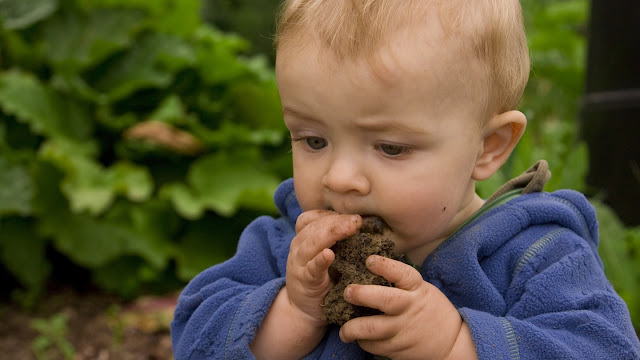Being a parent is a dream, but at the same time as being a parent, it is a difficult task to solve all the unknown problems so far.
Often parents have to deal with is that their kids consume soils, sands, mud, etc. which are often toxicants & they collectively cause deep damage to kids’ internal organs as well as external organs.
Why Children/Toddlers Eat Soil, Chalk and non Food type Items?
The simple Answer is: It appears to have a behavioral basis,
although some children may eat dirt or other substances because they lack
certain nutrients, such as iron or zinc.
The Term Use for This type of Disorder is called "Pica"
What is Pica?
Pica is an eating disorder in which a person eats something that is not
normally considered food. Young children often put non-food items (such as
grass or toys) in their mouths because they are curious about the world
around them. But pica children (PIE-kuh) go further. Sometimes what they eat
can cause health problems.
Some 10% and 30% of kids ages 1 to 6 years have Pica. The disorder is
defined as persistent and compulsive cravings (lasting 1 month or longer) to
eat nonfood items.
In most cases, pica usually manifests in people with other mental health
conditions. In fact, 10% to 15% of people with mental disabilities and
developmental problems also have pica.
The word “pica” is Latin for magpie—a bird known for eating almost
anything. Therefore, the pica eating disorder causes individuals to consume
non-food items.
To whom pica can affect?
Pica can affect children, teens, and adults. In children, it affects boys
and girls equally. Worldwide, 20 percent of cases involve pregnant
women.
Moreover, small children represent 25 to 33 percent of all pica cases.
But doctors don’t diagnose pica in children younger than two years old.
That’s because attempting to eat non-food items is a normal part of
childhood development among infants and babies.
What Causes Pica?
- Malnutrition in most developing countries.
- Nutritional Deficiencies of iron and zinc and calcium may trigger the cravings for these items.
- Developmental Problems like brain abnormalities/ autism/ developmental disabilities etc.
- mental health problems, like obsessive-compulsive disorder (OCD) or schizophrenia.
- Stress. Pica is often seen in kids living in poverty, or in those who've been abused or neglected.
Most pica occurs in young children and pregnant women. It is normal for
children under 2 to put things in their mouths. Therefore, unless the child
is more than 2 years old, this behavior is usually not considered an
obstacle.
As the child grows up, pica usually improves. But for people with
developmental or mental health problems, this is still a problem in later
life.
What are the signs and Symptoms of pica?
The symptoms of pica have a wide range, but they are all related to the
influence of ingested non-food elements. Pica symptoms are caused by toxic
or toxic substances and bacteria in ingested non-food. Symptoms may
include:
Symptoms of Pica:
In all those who are suffering with pica, the consumption of non-food
items is present. There are several categories of items consumed.
These include:
- Geophagy (earth): clay, dirt, rocks
- Amylophagy (raw starch): raw potatoes, rice, flour, corn starch, baby powder
- Pagophagia (ice) ranging from cups to pounds a day
Common signs of Pica include:
- Abdominal pain
- Nausea, vomiting
- Constipation
- Bloating
- Fatigue
- Poor nutrition
- Cravings
- Mineral deficiencies (iron, zinc)
- Lead toxicity
Evolution and diagnosis of Pica:
There are no specific tests to diagnose pica, so it is critical to be
forthcoming with medical and mental health providers about the nonfood
items being ingested.
Diagnosis is dependent upon self-reporting of the patient.
There are a few tests that physicians may order depending upon the
nonfood items a patient has ingested.
Blood tests to rule out lead poisoning and x-rays to determine
whether a patient may have a bowel obstruction are a few examples of
tests that a physician may perform in an individual with pica.
Treatment of Pica:
Treatment of Pica, vary with patient signs and symptoms. As mention
Below:
Nutritional Treatment:
With a balanced diet and adequate vitamins and minerals, pica symptoms
tend to diminish quickly.
If the person is unable or unwilling to adjust their food intake, the
professional may recommend dietary supplements (having Iron, Zinc
Vitamins) to stabilize and increase nutrients in the body.
Check on their calcium intake because deficiency of calcium also leads
children to eat soil. There are many calcium supplements especially for
kids.
Behavioral Therapies:
Some people in their peak can relieve symptoms quickly with nutritional
advice, dietary changes, and nutritional supplements. Others need
psychotherapy to reduce unwanted urges.
- Educating people and families about the "Pica" condition, including possible causes, risks and treatment ways.
- Creating a safe environment for the child.
- Removing nonfood items from the home.
- Increasing the supervision so the person cannot eat the nonfood items and blocking any attempts to do so.
- Distracting the patient’s attention away from the desired substance and rewarding them for discarding it.
For pregnant people, pica often stops spontaneously or after nutritional issues are addressed.
If you believe your pica is due to stress or anxiety, stress management techniques can help reduce the urges associated with pica.
Prevention and Conclusion:
There is no specific way to prevent pica. However, careful attention to
eating habits and close supervision of children known to put things in
their mouths may help catch the disorder before complications can
occur.
In conclusion, greater awareness is needed around pica eating disorder
and its symptoms, causes, and treatment. Hence, more people can be
protected from the harmful side effects of this condition, and set off
on the path to healing.














